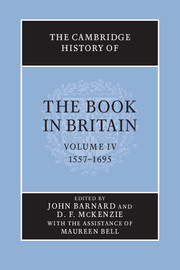Book contents
- Frontmatter
- Dedication
- Contents
- List of illustrations
- List of contributors
- Preface
- Acknowledgements
- Introduction
- RELIGION AND POLITICS
- ORAL TRADITIONS AND SCRIBAL CULTURE
- LITERATURE OF THE LEARNED
- LITERARY CANONS
- VERNACULAR TRADITIONS
- THE BUSINESS OF PRINT AND THE SPACE OF READING
- BEYOND LONDON: PRODUCTION, DISTRIBUTION, RECEPTION
- 32 The English provinces
- 33 Scotland
- 34 The book in Ireland from the Tudor re-conquest to the battle of the Boyne
- 35 Wales
- 36 British books abroad: the Continent
- 37 British books abroad: the American colonies
- DISRUPTION AND RESTRUCTURING: THE LATE SEVENTEENTH-CENTURY BOOK TRADE
- STATISTICAL APPENDICES
- Abbreviations
- Bibliography
- Index
- Plate Section
- References
34 - The book in Ireland from the Tudor re-conquest to the battle of the Boyne
from BEYOND LONDON: PRODUCTION, DISTRIBUTION, RECEPTION
- Frontmatter
- Dedication
- Contents
- List of illustrations
- List of contributors
- Preface
- Acknowledgements
- Introduction
- RELIGION AND POLITICS
- ORAL TRADITIONS AND SCRIBAL CULTURE
- LITERATURE OF THE LEARNED
- LITERARY CANONS
- VERNACULAR TRADITIONS
- THE BUSINESS OF PRINT AND THE SPACE OF READING
- BEYOND LONDON: PRODUCTION, DISTRIBUTION, RECEPTION
- 32 The English provinces
- 33 Scotland
- 34 The book in Ireland from the Tudor re-conquest to the battle of the Boyne
- 35 Wales
- 36 British books abroad: the Continent
- 37 British books abroad: the American colonies
- DISRUPTION AND RESTRUCTURING: THE LATE SEVENTEENTH-CENTURY BOOK TRADE
- STATISTICAL APPENDICES
- Abbreviations
- Bibliography
- Index
- Plate Section
- References
Summary
Authority and change
The history of the book in Ireland must, before it does anything else, take account of the continuing importance of manuscript tradition and the slow development of dependence upon the printed book in this period. Sixteenth-century Ireland became a kingdom under Henry VIII as part of a renewed attempt to bring Ireland under more complete and extensive British governance. This Tudor re-conquest was driven by two different but complementary ambitions: Henry, and subsequently his daughter Elizabeth, wanted to centralize authority throughout the islands of Britain and Ireland under their own administration in London; and they wished to further the reform of the Church in England and Ireland by making the crown the head of the Church as well as of the State. The achievement of these twin aims was to lay the foundations of a new, energetic Protestant polity; a vision in which Britain and Ireland were a conjoined imperium whose destiny was to bring into being a society which reflected the ideas of the Reformation under a settled form of authoritative government.
The printed book was one of the major instruments in the furtherance of the Reformation: people were encouraged to read the Bible for themselves and there flowed from the new presses all over Protestant Europe works of theology, philosophy, and biblical exegesis. England took a highly active part in this de-mystification of faith: for example, Richard Hooker’s Of the lawes of ecclesiasticall politie (1593–7) framed the Tudor concept which intertwined the settlement of the state with the Church’s interests and the rights and duties of the citizen.
- Type
- Chapter
- Information
- The Cambridge History of the Book in Britain , pp. 701 - 718Publisher: Cambridge University PressPrint publication year: 2002
References
- 3
- Cited by

